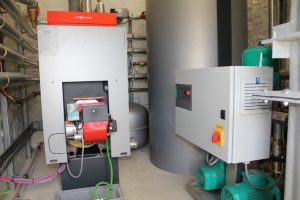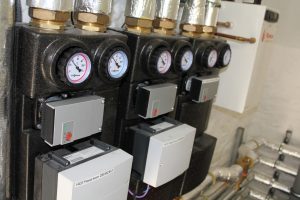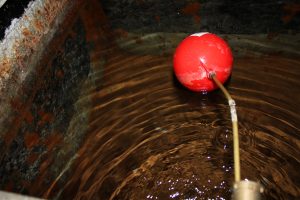MY DAY BEGINS . . .
It started earlier than usual, meeting our service engineer at the unit in Old Sarum at 7:30am to ensure we arrived at our first job on time at 8:00am.
Ready to start our day. . . .
JOB 1:
Our first port of call was a gas boiler service in Redlynch. After informing the customer of our arrival, we accessed the boiler in the garage. The engineer showed me how to safely remove the case of the Viessmann boiler to expose the inside. He talked me through each of the components that make the boiler work and then using the Viessmann toolkit (pictured below):
I was shown which parts needed to be removed in order to carry out the service. This is a careful process which begins with, most importantly, switching off the gas supply to the boiler. Once this is done, the burner needs to be removed in order to check the burner seal, electrodes and clean the heat exchanger as necessary. There is certainly a knack to the removal of the burner, undoing clips in the right order, followed by the screws and then removing the unit safely ensuring not to burn yourself or damage the part itself. Once this has been done, any wearing parts are then checked and changed if needed. On this occasion, we replaced the burner seal, which is a rubber ring that the burner leans on when placed back into the heat exchanger that houses it. Whilst the engineer did this, I used our dry vacuum followed by cleaning wipes to ensure there was no loose debris or dust inside the boiler. Once the boiler was put back together, we fired it up and put it into service mode. This allows the boiler to produce emissions as it would when in full demand and whilst it did this, we used the flue gas analyser to check the boiler was producing a safe gas reading. Once the gas readings were taken, they were printed on site and attached to the CP12 certificate that the engineer had already began writing out. This left me just enough time to finish my coffee and biscuits, before asking the customer to sign the CP12 and setting off to our next job.
JOB 2:
Our second job took us to an industrial warehouse building, much like our own for another gas boiler service on a Viessmann boiler. This time our engineer carefully watched as I carried out the initial checks, such as turning off the gas supply and unplugging the burner controls, unscrewing and removing the burner. I replaced the burner seal under the careful watch of our engineer. After giving the boiler a good clean inside and out, and completing the CP12 we were ready to leave another happy customer with a newly serviced boiler and move on to our 3rd job of the day.
JOB 3:
Our next job took us out to one of the first Viessmann oil boilers installed by AHS Ltd. On arrival, our customer wanted to tell us just how much of a difference he had noticed in the first year, by changing from his previous boiler to the energy saving Viessmann – always great to hear. Once again, our engineer talked me through the components that make up a Viessmann oil boiler and what parts needed to be checked during an oil service. I was impressed by the kit that accompanies these boilers that allows for an engineer to remove the main heat exchange, while being supported by a clip-in mechanism on the casing of the boiler. This is helpful due to the size and weight of the heat exchange and means less wires need to be unplugged and put back in. After checking all wearing parts, this time with no replacements needed and cleaning out the boiler, we completed the CD11 and had it signed off by the customer before leaving.
JOB 4:
Our final job of the day took us to Owslebury to look at a broken flush mechanism and leaking WC. Having read our jobsheet in advance, our engineer had an idea of what the issue might be and therefore how to resolve it. We therefore stopped off at our suppliers to pick up the materials and then headed on to the job. Arriving to a houseful of wedding guests, meant we had limited time to cut off the water supply and rectify the leak. Whilst our engineer dealt with this, I used our wet/dry vacuum to remove any water left in the cistern – ensuring to put down sheets to protect the customers floor from any water damage in the process. Once the water had been isolated and drained from the cistern, it was removed. We found the existing flush mechanism to be damaged and the doughnut washer was allowing water through. Whilst I constructed the new flush mechanism ready to be installed, our engineer replaced the doughnut. The replacement flush was then fitted, water switched back on and the WC tested 2 – 3 times checking it was in good working order and no leaks were apparent. Another happy customer!
MY EXPERIENCE:
The drive back to Salisbury bought us to 5pm and the end of our shift. I thoroughly enjoyed my day out in the field and not just for all the biscuits!
It was great to see a different aspect of my job and meet some of our customers. It was very nice to hear them praise the company’s previous work as well as their appreciation for the benefits of our installations. From an office workers point of view, it was rewarding to know that our well planned routes are worthwhile and save travel time in the day for our engineers. Overall, spending the day working with an engineer was a fun and interesting experience.
Written by ‘The Girl in the Office’



















